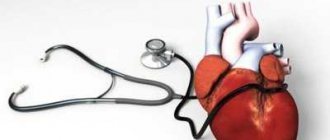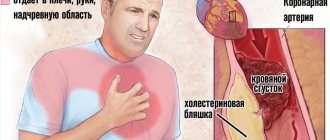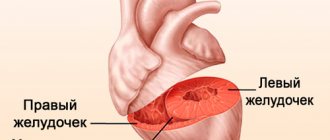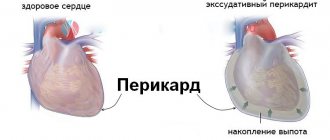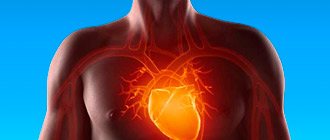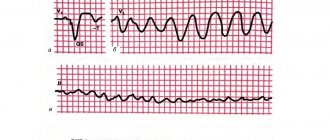What does hypertension with heart damage mean?
Hypertension with insufficient treatment leads to mandatory heart damage:
- the thickness and mass of the heart muscle increases (myocardial hypertrophy);
- the cavity of the left ventricle expands;
- the ability to pump blood decreases.
Therefore, the severity of the condition of patients with hypertension depends not only on the increase in blood pressure, but also on the degree of left ventricular hypertrophy. To feed a larger muscle, a lot of blood is needed, and the blood flow not only does not increase, but, on the contrary, weakens due to the high resistance of the arterial walls.
Hypertensive patients who have poor blood pressure control inevitably develop:
- coronary insufficiency (angina pectoris, heart attack);
- cardiac decompensation (swelling, shortness of breath, palpitations, blood congestion in the lungs).
We recommend reading the article about malignant arterial hypertension. From it you will learn about the causes of the pathology, symptoms, diagnosis and treatment, as well as possible complications. And here is more information about how thyrotoxicosis affects the heart.
Stages of progression
Changes in the heart do not occur immediately; the disease is characterized by continuous progression through stages (see table).
| Stage name | Main characteristics |
| First (functional changes) | There are no symptoms at rest, only during exercise (physical or stress), the myocardium’s need for nutrition increases, and the functioning of the left chambers of the heart is disrupted. It can only be detected with an ECG with exercise. |
| Second (hypertrophy of the left sections) | Thickening and increase in the mass of the myocardium, the filling of the cavities with blood decreases, pain in the heart occurs, and on the ECG at rest there are signs of overload of the left parts, followed by hypertrophy. |
| Third (dystrophy, weakening of the myocardium) | The heart muscle weakens and pumps less blood, cavities expand, pain and shortness of breath during exertion, and tolerance to physical activity decreases. |
| Fourth (heart failure) | A weak myocardium cannot push out the entire volume of blood, difficulty breathing, palpitations, swelling and wheezing in the lungs. |
Cardiac hypertrophy - symptoms
The clinical picture of the disease is quite blurry. In the initial stages, unpleasant symptoms are usually completely absent. As cardiac dysfunction progresses, new and painful signs appear.
Symptoms of hypertensive heart develop gradually and are not sudden
A hypertensive heart is characterized by a whole set of symptoms:
- sharp jumps in blood counts;
- pain in the heart with hypertension like angina pectoris, radiating to the back, stomach, shoulder blade, arm;
- shortness of breath, difficulty breathing, feeling of a lump in the throat;
- dizziness;
- cardiopalmus;
- swelling of the limbs;
- intermittent dry cough;
- pulling pain in the neck area;
- sleep disturbance, drowsiness during the day;
- loss of appetite;
- low performance, increased fatigue, constant fatigue;
- anxious thoughts and unreasonable fears, especially during an angina attack;
- increased sweating, mainly at night.
Often only one or a few prominent manifestations are present. You cannot ignore even a minor ailment; you should immediately consult a doctor. Timely diagnosis will help identify the disease at an early stage and prevent progression and complications.
Main symptoms of the disease: increasing pain in the left hypochondrium
Types of heart damage due to hypertension
Depending on the ratio of the mass of the heart muscle and its thickness, several types of heart damage in hypertension are identified (see table).
| Name | Ventricular thickness | Myocardial mass | Main reasons | Changes in the heart |
| Concentric hypertrophy | Promoted | Promoted | High blood pressure, crises | Large left ventricle |
| Eccentric hypertrophy | Promoted | Norm | Hypertension due to obesity and increased blood volume | The left ventricle looks like a ball, its cavity is dilated |
| Concentric remodeling (reshaping the heart) | Norm | Promoted | Hypertension with insufficient treatment | The shape of the ventricle is close to normal, but the ECG shows hypertrophy |
A completely normal structure of the left ventricle occurs only with low blood pressure levels - a mild form of hypertension, or proper therapy.
Disease prevention
In order not to experience such unpleasant symptoms with hypertension and try to reduce them to a minimum, you should give preference to a healthy lifestyle.
The doctor will prescribe a set of physical exercises to strengthen the cardiovascular system.
It is important to try to adjust not only your daily routine, but also your diet, take part in physical activity and regular medication. Below are some practical tips:
- Choose an option for physical exercises that will train the cardiovascular system and tone the body. It is advisable to contact a trainer.
- Healthy nutrition is an important factor in the fight against disease. It is important not only not to overeat, but also to stop drinking alcohol and caffeine-containing drinks. Give preference to freshly squeezed vegetable juices and still water. Don't overeat at night.
- Another way to reduce the symptoms of the disease is water procedures. Contrast showers and swimming pools are excellent for vascular training. However, it is important to consult with your doctor to avoid harm to your health.
- Don't forget about rest. You need to sleep more than 8 hours. Limit yourself from stress and nervous tension, fears and other emotions that are harsh on the body.
Correct habits and a healthy diet can give a noticeable effect in just 2-3 weeks. However, you should not resort to drug treatment alone or, on the contrary, ignore the instructions of doctors. It is important not to forget that an integrated approach to combating the disease will help to overcome the disease as quickly as possible.
Causes of development of hypertension with primary damage to the heart
The immediate cause of predominant cardiac damage in patients with hypertension is insufficient blood pressure control. When the heart muscle contracts, it has to overcome high resistance in the aorta. Therefore, the myocardium thickens and its mass increases. This is always accompanied by a lack of nutrition.
In recent years, it has been proven that heart damage is not only a response to stress. Also, in the body of a hypertensive person, a chain of hormonal changes (increased renin, insulin, aldosterone) and imbalance of potassium and sodium ions is triggered.
Hormones lead to thickening of the walls of the coronary vessels, which impairs nutrition (myocardial ischemia, infarction), and ionic imbalance can cause severe arrhythmia (fibrillation with cardiac arrest).
Risk factors
It was found that heart damage due to hypertension occurs more often in patients with risk factors:
- excess weight;
- age from 55 years;
- male gender;
- crisis course of hypertension with pressure surges up to 180/100 mm Hg. Art.;
- intense physical activity in untrained patients;
- alcohol abuse, including “beer heart”;
- hormonal changes during menopause, diseases of the adrenal glands, pituitary gland, thyroid gland;
- frequent emotional stress, mental stress;
- night work schedule, noise and vibration in production;
- salt consumption more than 5 g per day;
- heredity aggravated by hypertension and heart disease;
- kidney pathologies: pyelonephritis, glomerulonephritis, cyst;
- widespread atherosclerosis of the arteries;
- chronic infections (for example, inflammation of the tonsils);
- low physical activity;
- permanent residence in a region with unfavorable ecology.
Hypertension: heart
The heart is the first to respond to high blood pressure. In order to maintain normal blood circulation and supply oxygen to the entire body, it is forced to work in enhanced mode. Moreover, the higher the pressure, the harder the work the heart has to do. Because of this, the walls of the heart (mainly the left ventricle) gradually thicken (hypertrophy), and its size increases.
Initially, this, of course, helps the heart withstand increased stress. But an enlarged heart needs more nutrition, and the blood supply to the heart itself only worsens with hypertension. So the heart is not even able to feed itself!
Over time, the hypertrophied heart muscle simply depletes. The heart wears out and begins to work intermittently (arrhythmias develop). Then the walls of the heart gradually become thinner, lose their former elasticity, and the heart begins to weaken. It can no longer contract with the same force as before: the pump gradually loses power. This is how heart failure gradually develops: increased fatigue, weakness even after slight physical exertion, shortness of breath, and swelling.
For example, here is one of our pharmacy’s regular customers: a handsome man in the prime of his life, slanting shoulders, two meters tall. But he is hypertensive, and the hypertension is long-standing and advanced. The result is heart failure.
He gives the impression of being a healthy, athletic person. But at the same time, he can’t let alone go for a run, or even just walk at a brisk pace—he immediately begins to feel out of breath. A very indicative example of a frivolous attitude towards one’s own health in general and high blood pressure in particular!
As a result of heart failure, the blood supply to all organs and tissues is disrupted. This is the first step towards the emergence of all kinds of diseases. And in combination with hypertension, which further impairs blood supply, the risk of serious complications, including heart attack, increases almost fivefold!
What is a heart attack? This is the death of part of the heart muscle due to blockage of the coronary arteries that supply the heart. We have already talked about how this happens. But it is worth adding that if earlier doctors considered atherosclerosis to be the main cause of heart attack, now they are sure that hypertension alone is enough!
The first symptom of a heart attack is prolonged and severe pain in the heart (sharp piercing or squeezing, as if someone is squeezing the chest with a vice). The pain may be accompanied by pallor, severe weakness and dizziness, profuse sweating, heart rhythm disturbances, suffocation, nausea, vomiting, and fainting. But in any case, if the pain cannot be relieved with nitroglycerin, you must urgently call an ambulance and immediately take an aspirin tablet (it is best to chew “heart” aspirin, dosage 325 mg).
After a heart attack, blood pressure often drops. But it’s too early to rejoice at this - this is not a cure for hypertension. It’s just that part of the heart muscle has suffered, and the heart can no longer cope with the increased load. As the pump power decreases, the pressure also decreases.
You probably have at least one scar. Look: hair does not grow at the scar site. That is, the skin loses one of its functions. The same thing happens to a heart that has had a heart attack. In place of the dead tissue, scar connective tissue forms. But it is not able to work in the same way as the heart muscle, so it becomes increasingly difficult for the heart to fulfill its “duties”.
Let me remind you again: prevention, prevention and prevention again! If you reliably control your blood pressure and lead a healthy lifestyle, you are not at risk of a heart attack. And besides, I recommend that all hypertensive patients have an electrocardiogram at least from time to time. This is the most effective way to avoid dangerous heart complications, including heart attack!
Symptoms of hypertensive hypertension with predominant damage to the heart
The main criteria for hypertensive predominant heart damage in hypertension include 3 groups of symptoms: headache and/or dizziness, high pressure readings when measured, pain in the heart area.
Headache and accompanying symptoms
The most common symptom of the disease, which occurs in 95% of patients, is headache. It can be isolated or combined with episodes of dizziness and tinnitus. Classic option for hypertension:
- pressing and dull, less often burning;
- more in the morning, decreases towards noon;
- in the back of the head;
- pulsation in the crown area;
- a feeling of heaviness or fullness in the temples and frontal area;
- worsens with stress, mental work and excessive physical activity.
The second type of pain appears during emotional overstrain and decreases with relaxation. More often aching, monotonous.
When the disease is very severe, the third type occurs:
- intense, unbearable;
- in the back of the head with distribution throughout the entire head area;
- accompanied by nausea and vomiting.
As a rule, it occurs when intracranial pressure increases and is dangerous due to the development of cerebral edema.
High Pressure Detection
In some patients, hypertension occurs latently, and periodic headaches do not cause severe discomfort; they are explained by overwork. Therefore, in approximately half of the cases, the detection of indicators from 140/90 mm Hg. Art. is a complete surprise. The diagnosis is made if such episodes are repeated at least twice during a visit to the doctor.
It is important that it is precisely in hypertensive patients that it is difficult to detect a connection between high numbers and well-being. It happens that the patient does not feel readings above 170 units, while other patients already at 150 complain about:
- heaviness or pain in the head;
- flickering of flies;
- increased fatigue;
- nosebleeds that bring relief;
- cardiopalmus.
For the condition of blood vessels and blood circulation, not only high pressure is important, but also its changes.
Heart pain
Increased pressure leads to a high load on the heart during the contraction phase, and during the relaxation period, not enough blood enters the coronary vessels due to myocardial hypertrophy. Therefore, the heart does not have enough nutrition and oxygen, which causes pain.
They, in contrast to typical angina (ischemia), are characterized by:
- short attacks;
- can be both at rest and under load;
- low or moderate intensity (the patient can continue to move and do normal work);
- are felt not in the middle of the chest (behind the sternum), but on the left side (in the area of the projection of the heart);
- weaken after normalization of pressure;
- are not removed by Nitroglycerin.
In older people, hypertension is often combined with angina, so the nature of the pain may change. For young patients, sharp but short sensations are typical; they radiate under the shoulder blade or to the left arm. Less likely to appear are long-lasting and aching ones due to stress or physical overload.
If hypertension is complicated by heart failure, then the following is added to the pain:
- shortness of breath during physical activity;
- low load tolerance;
- swelling in the legs;
- heaviness in the right hypochondrium.
Useful video
Tips on how to get rid of high blood pressure and heart pain:
In order to quickly normalize the body's condition during hypotension, which is accompanied by chest pain, you need to do moderate physical exercise. A healthy lifestyle that is devoid of stress and depression will help protect the body from unpleasant sensations in the myocardium.
The information on the MyMedNews.ru website is for reference and general information, collected from publicly available sources and cannot serve as a basis for making a decision on the use of medications in the course of treatment.
MyMedNews.ru
And we also have
Is pressure 130 over 60-70 considered normal and what do these indicators mean?
What is the danger of stage 3 hypertension with heart damage?
At stage 3 of hypertension, complications develop; heart damage can manifest itself in:
- angina pectoris – attacks of chest pain; if prolonged, myocardial infarction is possible;
- acute circulatory failure - cardiac asthma, pulmonary edema;
- dissecting aortic aneurysm - protrusion of the wall with penetration of blood between the membranes of the vessel, dangerous due to severe internal bleeding;
- sudden cardiac arrest;
- complex form of rhythm disturbance;
- progressive chronic heart failure.
Heart damage may be predominant, but in most patients, disorders in other target organs are also found:
- brain - stroke, intracerebral hemorrhage, encephalopathy (deterioration of functions);
- retina of the eye - hemorrhage, vascular changes (retinopathy), blurred vision;
- kidneys – shrinkage (nephrosclerosis due to proliferation of connective tissue), acute or chronic decrease in urine filtration (renal failure), renal infarction;
- reproductive system - impotence.
What is hypertension
Hypertension is a disease characterized by a constant or periodic increase in blood pressure. The basis of hypertension is tension in the walls of the arteries, which causes a narrowing of their lumen. The movement of blood through the vessels is difficult. Blood pressure on the vessels increases. Possible increase and decrease in pressure. When engaging in physical education, blood pressure increases. In a calm state it decreases.
High blood pressure contributes to the development of cardiac muscle hypertrophy.
Hypertension is a fairly common phenomenon, mainly in industrialized countries. Primary hypertension without morphological changes in blood vessels can cause some functional disorders of the central nervous system. In the initial period of hypertension, called functional, hypertrophy of the heart muscle develops, gradually progressing and leading to a series of changes in the myocardium, ending in their failure. In the second phase of hypertension, morphological damage to blood vessels and the organs they feed occurs.
Return to contents
Hypertensive heart disease with kidney damage
The second most common form of hypertension after heart changes is kidney damage, or nephropathy. High blood pressure leads to poor nutrition of these organs. Instead of normally functioning glomeruli, rough fibrous tissue grows, and the kidney shrinks.
The ability to cleanse urine decreases. Against this background, renal failure develops and progresses. The renal form of hypertension itself becomes a factor in increasing blood pressure. In response to decreased blood flow, more substances that constrict blood vessels (renin-angiotensin-aldosterone cascade of reactions) are produced.
An important feature of kidney damage is its mild course in many patients. Typical signs of high blood pressure come to the fore, and a disorder can initially be suspected only by frequent awakenings at night to go to the toilet.
When the form is advanced, swelling of the face appears in the morning, more noticeable under the eyes. At first they go away on their own by the middle of the day, then they become stable. Patients note that the urge to urinate becomes more frequent, but a small amount of urine is released each time.
These signs are gradually added to by dry skin and an unpleasant odor of urea from the skin and from the patient’s mouth. All these manifestations characterize the onset of renal failure.
Treatment of hypertensive heart
Treatment of the disease involves a predominantly medicinal approach. Special medications are used for heart failure and hypertension to control blood pressure levels, improve blood circulation, and stabilize myocardial function.
Experts prescribe:
- angiotensin-converting enzyme inhibitors (ACEIs) - Captopril, Lisinopril, Renitek;
- beta-blockers - “Nebivolol”, “Anaprilin”, “Bisoprol”;
- diuretics for hypertension and heart failure - Furosemide, Indapamide, Klopamide;
- alpha-blockers - Alfuzosin, Doxazosin, Tamsulon;
The action of medications prescribed for the disease is aimed at removing excess stress from the heart.
- vasodilators (vasodilators) - Nitroglycerin, Dibazol, Drotaverine;
- antithrombotic (antiplatelet agents) - “Aspirin”, “Alprostan”, “Aspikor”;
- sartans - “Losartan”, “Renicard”, “Cardosal”;
- statins (lipid-lowering drugs) – “Simvastatin”, “Lovastatin”, “Cardiostatin”.
In an advanced form of the disease, when the pressure cannot be normalized, ischemia and heart failure are present, conservative therapy does not help, and the patient’s condition is rapidly deteriorating, a decision is made on surgical intervention. To avoid heart attack and cardiac arrest, several advanced methods are used - cardiomyoplasty, implantation of a pacemaker, implantation of an artificial left ventricle.
The doctor selects a suitable therapeutic complex and treatment regimen; self-medication is prohibited.
Diagnosis of the patient
To detect damage to the heart muscle due to hypertension, an ultrasound of the heart and an ECG are performed. Ultrasound helps:
- identify thickening of the walls and immediately measure them;
- calculate myocardial mass using formulas;
- determine the relationship between heart volume and body surface area (the most accurate sign of hypertrophy).
When interpreting the ECG, attention is paid to the symptoms of left ventricular enlargement and deterioration of heart nutrition (ischemic changes). Often, to identify them, tests with physical activity (an exercise bike, a treadmill) are needed.
These basic diagnostic methods are necessarily complemented by:
- blood pressure measurements in 24-hour monitoring mode, including at night;
- blood tests: general, kidney tests, potassium and sodium, glucose, cholesterol and lipids;
- urine tests: general, Rehberg test, according to Nechiporenko, Zimnitsky;
- examination of the vessels of the fundus (performed by an ophthalmologist);
- Ultrasound of the kidneys, and according to indications, the adrenal glands and the thyroid gland;
- electroencephalography, examination by a neurologist.
Treatment of the disease
Light physical activity for hypertension has a positive effect on blood circulation.
Physical education and sports have a positive effect on the mechanisms that regulate blood circulation. Dosed physical activity helps strengthen and develop the function of the circulatory system and reduce neurotic reactions. Morning warm-up, exercises, walks in the fresh air, outdoor games, and occupational therapy are shown. Gymnastic exercises should be accessible to perform, simple in construction, without forceful tension. They are performed rhythmically, at a calm pace, alternating with breathing exercises. It is important to regulate the motor mode throughout the day, alternating active forms (gymnastics, occupational therapy) with passive rest.
Treatment methods
In order to normalize the condition of the heart, it is necessary first of all to achieve a constant blood pressure at the level of 110-139/80-89 mm Hg. Art. For this purpose, medications, folk remedies, and a special diet are used.
Traditional medicine
After the hormonal effect on changes in the heart during hypertension was proven, it was found that the most effective drugs are (in descending order):
- angiotensin receptor blockers - Lozap, Exforge;
- angiotensin-converting enzyme inhibitors (ACEIs) – Accupro, Prestarium;
- long-acting calcium channel blockers – Lerkamen, Nimotop;
- diuretics – Indapamide, Arifon;
- beta blockers – Metoprolol, Bisoprolol.
These medications and their analogues have the ability to:
- reduce existing left ventricular hypertrophy;
- normalize the condition of blood vessels;
- inhibit the growth of smooth muscles in the arterial wall;
- prevent heart failure;
- reduce the risk of heart attack and sudden death from cardiac arrest.
Expert opinion
Alena Ariko
Expert in Cardiology
The most common mistake of patients with hypertension is stopping treatment when the pressure normalizes. The desired effect of the drugs is achieved only with constant use, but the doctor must adjust the dose and replace it with weaker drugs. Changing the treatment regimen on your own greatly reduces its results.
Traditional methods
Traditional methods for hypertension with heart damage are used only as an adjuvant. They do not affect the degree of myocardial hypertrophy in any way, but they can help:
- reduce nervous tension - lemon balm, hop cones, motherwort herb, peony root;
- remove excess liquid - horsetail, lingonberry leaf, knotweed, rose hips;
- reduce heart rate – hawthorn, valerian;
- strengthen vascular walls - rose hips, chokeberry.
Most often, collections from several plants are used, for example:
- chokeberry (berries) – 20 g,
- hawthorn fruits – 20 g,
- rosehip berries – 20 g,
- motherwort herb – 20 g,
- peony root – 20 g.
For one tablespoon of crushed ingredients you need 300 ml of boiling water. They are placed in a thermos overnight and taken 2 tablespoons 30 minutes before each meal. The course of application is one month.
Diet
The rate of progression of hypertension and the risks of complications largely depend on nutrition. Main principles:
- refusal of salty foods completely, prohibited canned food, marinades, pickles, seasonings with salt, cheese, sausages, chips, semi-finished products, salty cookies, soup cubes;
- inclusion in the diet of fresh or boiled vegetables, herbs (they form the basis of the diet), berries and fruits;
- restrictions on fatty, fried and spicy foods that retain fluid in the body;
- exclusion of alcohol;
- introduction to the menu of boiled and baked fish, seafood, lean meat, fresh fermented milk drinks, cottage cheese with 2-5% fat content;
- All dishes are prepared without salt, and it is handed out for adding salt (3-5 g per day).
Water consumption and the total amount of fluid must be calculated individually; it depends on daily diuresis and the presence of edema and blood stagnation. If you are overweight, it is necessary to reduce it in order to facilitate the work of the heart. To do this, determine the daily calorie intake; it should be lower than physical activity.
Hypertensive heart
It is not difficult to diagnose. When the heart muscle expands to the left, the heart rate increases, tremors are observed between the sixth and seventh ribs, and a diagnosis of hypertension is made. #8212; Doctors say that this patient has a hypertensive heart. Although these symptoms can be observed without the presence of hypertension.
With a hypertensive heart, there are two options for the course of the disease - a decrease in blood pressure is observed or inflammatory processes occur, in which significant changes in the heart are observed. Such processes include chronic myocarditis, coronary atherosclerosis and other inflammations. The myocardial fibers gradually die, and the remaining portion bears an increased load. Heart failure occurs because healthy fibers are not able to carry such an overload.
In order to correctly diagnose changes in the heart muscle due to various diseases (cardiosclerosis and myocarditis), the results of cardiac X-ray and ECG come under the close attention of doctors.
A disease such as hypertensive heart can develop as a result of an infectious disease. In most cases, this occurs after the patient has had scarlet fever or diphtheria. This disease can also occur as a result of various fungal diseases, viral infections, and inflammatory processes in the body. Scientists and doctors still cannot explain how often an inflammatory process in the myocardium begins during an infectious disease. However, these days the diagnosis of myocarditis is made much less frequently.
One of the types of myocardial inflammation is the so-called isolated myocarditis. Diagnosis of this disease occurs by exclusion, when no common disease matches the symptoms. If the patient is young or middle-aged (20-55 years), and the disease develops quite quickly, then in 50% of all cases, insufficiency of the heart muscle is diagnosed.
Changes in the heart can also occur after atherosclerosis of small or large coronary arteries. In both cases, coronary heart disease occurs, and the muscle dies, and the connective tissue that replaced it cannot perform all functions. Therefore, the load on the remaining muscle volume increases. Hence the conclusion is that a hypertensive heart occurs as a result of severe overload of the myocardial muscles. The most common cause of heart failure is cardiosclerosis, the risk of which increases the older a person gets.
Video: High Blood Pressure and Bodybuilding
Cardiologist Online is a site for those interested in cardiology and heart disease. Currently, heart disease occupies a leading position in morbidity statistics, so it is extremely important to learn to recognize the early signs and symptoms of heart disease.
Copyright Cardiologist Online
When using site materials, a hyperlink to https://kardiolog-online.com/ is required. For advertising and cooperation, please contact [email protected] Information on the site is published for informational purposes only and cannot be used as a guide to action without consulting a doctor or other specialist.
Yaroslav Bykov 21 Feb. 2020 Blood Pressure Average Score0
People of all ages suffer from high blood pressure. Chronic hypertension is diagnosed in every second patient in adulthood. The disease negatively affects not only blood vessels, but also affects vital organs, in particular the heart. If there is a persistent disruption of the functioning of the heart muscle, a diagnosis of “hypertensive heart” is made - what it is, why it occurs and how to cope with the pathology, we will understand in detail.
When does hypertension need to be treated in a hospital?
To clarify the diagnosis and conduct an in-depth examination, the patient may be prescribed planned hospitalization; it is also needed to select treatment for:
- resistance to major groups of drugs;
- difficulties in determining the dose;
- pressure surges;
- frequent crises;
- suspected complicated course of hypertension.
Urgent hospitalization is prescribed for patients with:
- severe hypertensive crisis, which the ambulance team could not relieve;
- increased likelihood of myocardial infarction, stroke, pulmonary edema;
- sudden loss of vision.
Watch the video on how to overcome a hypertensive crisis:
How does a doctor diagnose cardiac hypertension?
Complaints are analyzed, the patient is examined, standard and biochemical blood and urine tests are prescribed. The best data on blood pressure readings for a daily period is provided by a Holter study, which the doctor prescribes if the patient has complaints of frequent dizziness, headache, or tinnitus. The pressure is recorded with a special device every 15 minutes.
An ECG study reveals the nature of the rhythm and the pathology of the conduction system of the heart.
X-ray of the lungs allows you to see the initial signs of congestion.
An ultrasound is performed to detect enlargement of the walls of the ventricles of the heart and the nature of blood flow in the vessels.
Prevention measures
To prevent high blood pressure and heart damage, you need to:
- stop smoking;
- normalize body weight;
- reduce daily alcohol consumption to 30 g in terms of ethyl alcohol (for women up to 20 g);
- engage in sports (physical education), training should be at least 150 minutes per week;
- reduce salt intake to 5 g (it is better to replace table salt with Adyghe salt, which contains more potassium);
- increase the share of plant foods in the menu, reduce the percentage of animal fats.
If hypertension has already developed, daily blood pressure monitoring and the use of prescribed medications are important. It is necessary to maintain indicators at a level not higher than 140/90 mmHg. Art., and in the future it is better to reduce it to 130 or less units.
We recommend reading the article about arterial hypertension in old age. From it you will learn about the reasons for changes in blood pressure, risk factors and ways to normalize indicators. And here is more information about complicated hypertensive crisis.
Hypertension with damage to the heart is dangerous due to complications such as myocardial infarction, aortic aneurysm, pulmonary edema, and sudden cardiac arrest. To prevent their development, constant treatment and regular monitoring of blood pressure and circulatory conditions are necessary.
Diagnosis of pain
To make an accurate diagnosis, a patient who has heart pain or other symptoms requires a comprehensive examination and diagnosis. This helps to prescribe the correct treatment. The question of the possibility of the existence of symptomatic hypertension should be raised in all cases of increased pressure. Patients with hypertension that arose at a young age and patients in whom the disease worsens require close attention and thorough special studies.
Treatment should be early, comprehensive, and long-term. When choosing treatment methods, it is rational to be guided by the stage of the disease. Stage I of the disease does not require special drug therapy; psychotherapeutic influences and regulation of the regimen are needed. Further stages require the use of special medications. Surgical interventions have also been proposed to reduce blood pressure. Contraindications to surgery: heart failure, circulatory disorders, impaired renal function. However, surgery is only a link in therapeutic measures.
Symptoms
Signs of hypertensive heart disease with heart failure depend on the predominance of the type of initial myocardial disorder and the duration of the pathological process. The physiological manifestations of the disease can be determined visually, namely:
- the upper body is getting better;
- a large number of stretch marks (purple stretch marks) appear on the skin;
- there is a heart murmur caused by arterial stenosis;
- shortness of breath occurs in various positions lying and standing, and further as the disease develops at rest;
- fatigue from physical activity appears;
- kidney function is disrupted and little urine is produced;
- there is a constant feeling of thirst;
- feels drowsy;
- I am bothered by painful tingling in the solar plexus area.
Heart rhythms may be sinus, especially before atrial fibrillation. Heartbeats and their frequency may indicate pathological tachycardia.
Additional symptoms of this hypertension are an irregular pulse (with coarctation of the aorta), increased pressure to levels above 140/90. In patients with heart failure, a distended jugular vein may be observed. There may be congestion and wheezing in the lungs.
Methods of treating pathology
The effectiveness of treatment directly depends on how early the disease was diagnosed. In any case, you should not try to cure this disease on your own. This requires qualified assistance from a specialist. Only a doctor can conduct a full examination and prescribe effective treatment.
This may be limited to daily medication, or may require inpatient treatment in a hospital. Diet plays an important role in treatment. Folk remedies and home therapy can also help. But if all these methods cannot correct the situation, surgical treatment is prescribed for severely ill patients.
Description of the problem
The main complication caused by hypertension is insufficient blood supply. It implies the following: the power of the heart required to perform all functions differs from the power of a healthy organ. The “flame motor” of the human body is no longer so elastic and pumps blood less efficiently than during normal operation. Nutrients and oxygen are poorly supplied to the heart. Blood passes through the pumping chambers slowly, and the pressure inside the atria and ventricles increases. It is a chronic disease that requires systematic outpatient care, as well as inpatient therapy and examination.
With high blood pressure, the need for blood supply to tissues and organs that are related to the pulmonary and systemic circulation increases. There are systemic (left ventricular) and pulmonary (right ventricular) hypertensive heart disease. In the first case, systemic hypertension is to blame, i.e., an increase in hydrostatic pressure in the arteries of the systemic circulation, in the second - pulmonary hypertension, i.e., high blood pressure in the pulmonary circulation.
Diagnosis of hypertension
Symptoms will help determine that there are health problems, but only a specialist can diagnose the disease. To do this, he needs to collect the entire range of tests.
While palpating the heart, the specialist should feel a shift of the impulse to the left and down in the upper part of the organ, as well as a shift to the left of the border of the heart muscle. Auscultation will help him identify murmurs and increased rhythm.
The doctor will be able to make the main diagnosis only after conducting urine and blood tests, determining the antibody titer to streptococci, ECG, EchoCG, radiography and Holter monitoring.
